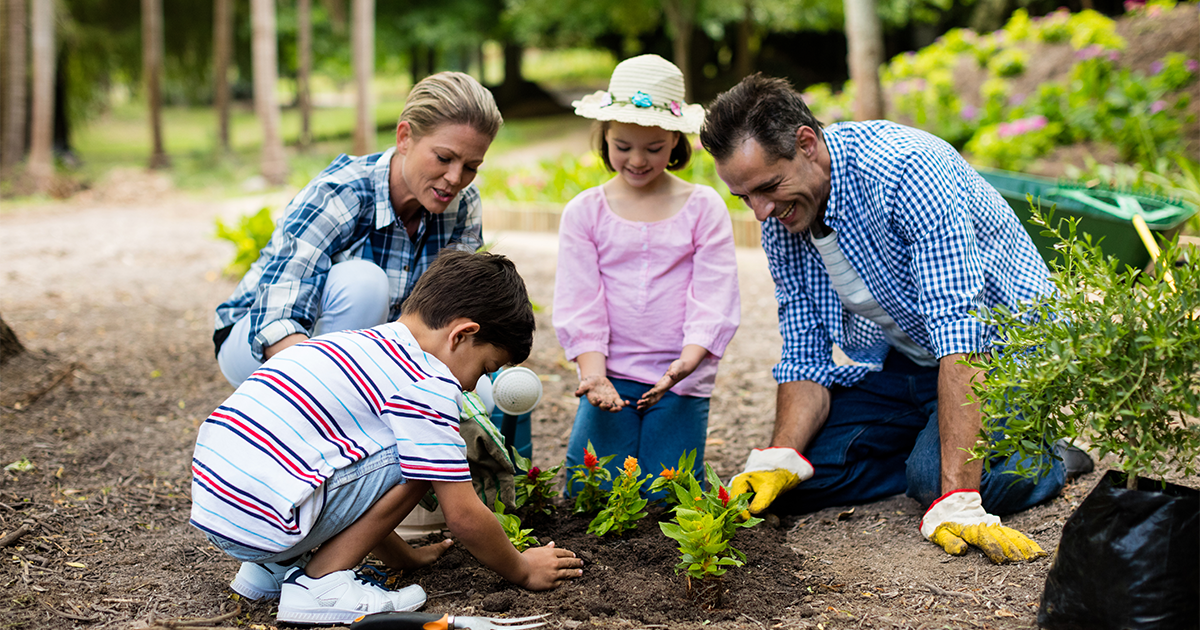A Beginner’s Guide to Gardening

In the last decade, a new hobby has taken hold in America: gardening.
More and more people are discovering the joys of keeping a garden. A recent study found that since 2009[*]:
- 17% more Americans have started gardening
- 63% more millennials have started gardening
- 33% of households grow some of their own food
Why the sudden upswing in gardening? It may be that people want to eat better produce. It could be a desire to spend more time outdoors in an increasingly indoor world. Or it could be the simple pursuit of beauty -- the pleasure of seeing a marigold bloom or a sapling grow its first leaf.
Whatever the reason, gardening is a relaxing and productive hobby, and it’s becoming more popular than ever.
If you want to start gardening, this article has everything you need. It covers all the basics, including the following sections:
- Choose your plants
- Find your growing season
- What your plant needs to grow
- Basic gardening tools
- Plant your garden
- Water your garden
Gardening may seem overwhelming at first. Just relax and take your time going through this guide. You’ll be growing your first plant in no time.
Step 1: Choose Your Plants
The first step in gardening is choosing what plants you want to grow. In order to choose, you have to know your planting zone.
Plants are sensitive to their environment, especially when it comes to temperature. A palm tree won’t thrive in the arctic and a delicate spring flower will burn up in desert heat.
Fortunately, the U.S. Department of Agriculture has a planting zone tool that uses temperature data to help you figure out which plants will thrive in your area. You just put in your zip code and the tool tells you which planting zone (also called a hardiness zone) you live in, from 1-11.
Most seeds have ideal planting zones listed on the packet. You can also do a quick Google search to find good plants for your area.
Example
Let’s say you live in Rowe, Massachusetts and you want to grow vegetables.
You put your zip code (01367) into the USDA planting zone tool and discover that you’re in planting zone 5b.
A quick Google search of “zone 5b vegetables” reveals that asparagus, beets, broccoli, carrots, Brussels sprouts, cabbage, and a host of other plants will thrive in your garden.
Now you know what to grow. The next step is figuring out when to start planting.
Step 2: Find Your Growing Season
Frosts -- sudden freezes from a drop in temperature -- can kill your plants before they’ve had a chance to grow. They happen throughout winter and usually end in spring.
A growing season is the time between the last spring frost and the first autumn frost. During your growing season, plants will thrive because they’re safe from frosts (though some especially hardy plants, like pine trees and other evergreens, can survive year-round with no issues).
Again, there’s an easy tool to figure out your growing season. The Farmer’s Almanac growing tool will tell you first and last frost dates, as well as the length of time between them. As long as you plant in that window, your plants should be safe (unless there’s an unseasonably late or early frost).
Once you know your growing season, you have to figure out how long your plants take to grow. Arugula, for example, grows from a seed in 3-4 weeks, while celery takes a full 16 weeks.
You want to plan ahead to make sure your plants grow before the last frost of the year. Otherwise they may die before they bloom or are ready to harvest.
Example
Let’s continue with the Rowe, Massachusetts example. You’re in planting zone 5b, and you’ve decided to grow beets.
First, you go to the Farmer’s Almanac growing tool and type in your zip code (01367). You see that the last spring frost of the year is May 16th, and the first autumn frost is September 24th. That leaves you with a growing season of 127 days in between.
A Google search of “beets growing time” reveals that beets take 45-60 days to grow, from seed to harvest.
That means the latest you can plant beets is 60 days before September 24th, the first autumn frost. You need to plant your beets by July 26th.
Step 3: What Your Plant Needs To Grow
Every plant needs three things to grow:
- Sun
- Water
- Soil nutrients
Balancing these three elements is the key to gardening. Each plant is unique -- some need lots of sun and not much water, while others are constantly thirsty but thrive in the shade.
Here’s how to harness sun, water, and soil to help your plants grow.
Sun
Plants absorb sunlight through a process called photosynthesis -- they convert sunlight into energy that helps them grow.
Most plants fall into one of three categories:
- Direct sunlight. This means 6+ hours per day of full, uninterrupted sunlight. Many fruits and vegetables fall into this category.
- Partial shade. Some sun, maybe from morning sunlight, with shade throughout the hottest parts of the day. Many spring flowers do best with partial shade.
- Full shade. Minimal sunlight, with protection from the sun for most of the day. Ferns, mosses, ivies, and delicate shrubs often thrive in the shade.
Does your yard get full, direct sunlight for most of the day? You’ll want to choose plants that thrive in sunlight, or make artificial shade by draping a shade cloth over plants that prefer sun protection.
Is your yard shady for most of the day? Look for plants that prefer cooler, darker climates.
Most plants and seeds list their sun requirements on their packaging. You can also always do some online research.
Water
Plants convert sunlight, carbon dioxide from the air, and hydrogen from water into sugar, their main source of energy.
Without water, your plants won’t be able to make food, and they won’t grow.
Just like with sunlight, different plants need different amounts of water. Some are quite thirsty and want water every day, while others can go days or even weeks without a watering.
You can find out a plant’s specific water needs by searching online.
Soil Nutrients
All the other nutrients a plant needs come from soil. A plant lays down roots, and when you water the soil, essential minerals dissolve into the water. Then the roots drink up the water, nourishing the plant so it can grow.
There are two main things to think about when it comes to soil:
- Nutrients. Plants need 13 essential minerals to grow. If your soil doesn’t have certain nutrients (and many soils don’t), your plant will struggle to survive. For that reason, many gardeners add fertilizer like manure, compost, or packaged plant nutrients to make sure their plants have all the nutrients they need. You can find fertilizers at your local home improvement store, or you can order all-purpose fertilizer online.
- pH. This is a measure of a soil’s acidity. If soil is too acidic or too alkaline, your plants won’t be able to absorb nutrients, and they won’t grow. Most plants want a soil pH of between 6.0 and 7.0.
If you’re a new gardener, make life easy on yourself and get a soil testing kit. You take a sample of your soil, mail it in, and within a few days, you’ll get back a full report on your soil.
The report includes nutrients and pH, as well as exactly how much fertilizer and other compounds to add to make your soil fertile.
If you’re doing raised-bed planting (see below), you can also skip all this and just fill your garden beds with bags of soil from your local home improvement store.
Example
It’s June in Rowe, Massachusetts, which means it’s time to plant your beets. You google “beets sun needs” and discover that beets do best in full sun.
Then you google “beets water needs” and see that beets need at least an inch of water every week -- that’s one or two good, deep waterings.
Half your backyard has almost no shade -- it’s bright and sunny all day. The other half is shaded by your neighbor’s trees. You choose an area in the sunny part and decide to plant your beets there.
Step 4: Basic Gardening Tools
You’re almost ready to start planting! The last things you need are a few simple gardening tools.
A raised garden bed is a great way to start your first garden. It’s basically a box that you fill with soil, then use to plant your garden. You can buy raised garden beds at your local home improvement store, or you can make your own out of plywood and brackets.
Raised garden beds give you more control over your soil quality, but if you want to skip them, you can also plant directly into the ground.
Either way, you’ll need the following:
- Trowel. Used for digging in soil by hand, and for harvesting vegetables.
- Watering can. Used to water plants by hand (unless you’re using a watering system discussed below).
- Shovel. Used to move large amounts of soil or fertilizer, or to dig holes for larger plants.
- Rake and Hoe. Used to remove weeds and till the soil, which prevents it from getting compacted so that water and oxygen can’t get through it.
- Bulb planter (optional). If you’re planting flowers that grow from a bulb, a bulb planter will make your life much easier by digging a perfect, bulb-shaped hole for planting.
With these tools, you’ll have everything you need to start planting.
Step 5: Plant Your Garden
Now that you have all the knowledge and tools you need, it’s time to start planting your garden.
Most people start their garden from seeds, which is a simple and affordable option. The majority of vegetables and flowers grow easily from seeds.
However, if you have a short growing season or you want your plants to mature faster, you can also buy small starter plants (or bulbs for flowers) that already have a few weeks of growth.
You can find both seeds and starter plants at your local home improvement store.
If you’re using a raised garden bed, fill it to the top with soil. If you’re planting right into the ground, use your hoe to till the soil -- drag the hoe across the ground -- until the soil is loose and easy to handle.
To plant from seeds, simply follow the directions on the seed packet. Different seeds prefer to be planted at different depths. Some like to be right on the surface, while others prefer to be planted a couple inches under the surface. Your seed packet will tell you what you need to know.
To plant a starter plant, dig out a hole using your trowel or shovel that’s big enough to fit the plant and its roots. Then remove the plant from its plastic pot, put it in the ground, and pack soil around it so it stands upright and is the same level above ground that it was in the container. The roots should be covered with soil.
You want to give your plants room to grow, so plant the seeds a few inches apart from one another in a neat row. That way they won’t get crowded as they sprout.
That’s it! Your plants are in the ground and are ready to start growing. All they need is water.
Example
You have your beet seeds, you bought a raised garden bed, and you’ve chosen a sunny plot of land in your backyard. It’s time to plant.
You fill the garden bed with all-purpose soil you bought at your local home improvement store. Your beet seed packet says to plant the seeds ½-inch deep and 2 inches apart, in rows that are 1 foot apart from each other.
You sprinkle the seeds into appropriately spaced rows and cover them with about ½-inch of soil. You’ve done it; your beets are ready to start growing.
Step 6: Water Your Garden
All the hard work is done. Now you just have to water your plants and watch them grow.
Each plant has different watering needs, and watering depends on a few different factors. If you live somewhere with intense heat and dry air (like a desert), you may need to water every day. If you get a lot of rain throughout your growing season, you may hardly need to water at all.
A good general rule is to keep the top 3-4 inches of your soil damp. Stick your finger into the soil all the way to the base of your knuckle. If the soil is damp, your plants are probably happy. If the soil is dry, it’s time to water.
Here are a couple basic tips for watering:
- Water in the early morning or evening. If you water during the day, the sun will evaporate a lot of the water. It’s a waste of water, and it makes it hard for you to gauge how much water your plants are really getting.
- Do fewer, deeper waterings. You want water to make it all the way down to your plants’ roots. It’s better to do a couple deep waterings each week than to give your plants a shallow watering every day. The exception is if you’re in a very hot, dry place, like a desert. In that case, you may want to do deep watering every day.
You can water a few different ways:
- Watering can. Classic, cheap, handheld. Watering cans are a good choice for beginners, although they’re the most time-consuming and labor-intensive way to water.
- Hose and nozzle. Use your hose connection to spray water across your plants. Faster and more even than a watering can.
- Above-ground oscillating sprinkler. Hook it up to your hose connection and turn it on for a few minutes every day. It’ll water your whole garden automatically with minimal effort on your part. Just don’t forget to turn it off.
- In-ground sprinkler with B-hyve timer. The easiest and most environmentally friendly way to water. Just install the in-ground sprinkler system and set the B-hyve smart home water timer, and your plants will enjoy perfect watering, every time. The B-hyve connects to WiFi and uses weather conditions to predict exactly how much water your garden needs. You can control it from your smartphone or laptop, there’s minimal water waste, and you never have to worry about forgetting to water your plants again.
Final Thoughts
Gardening is a relaxing and enjoyable way to get in touch with nature. With a few minutes of research, seeds, and some basic tools, you’ll have everything you need to start your garden today.
And if you don’t have a yard (or outdoor gardening seems intimidating), why not start an indoor garden? Growing houseplants or herbs is a great way to get familiar with plants from the comfort of your home.





